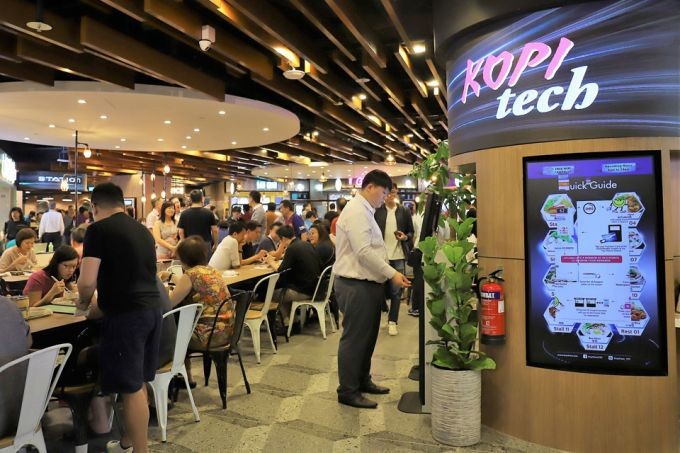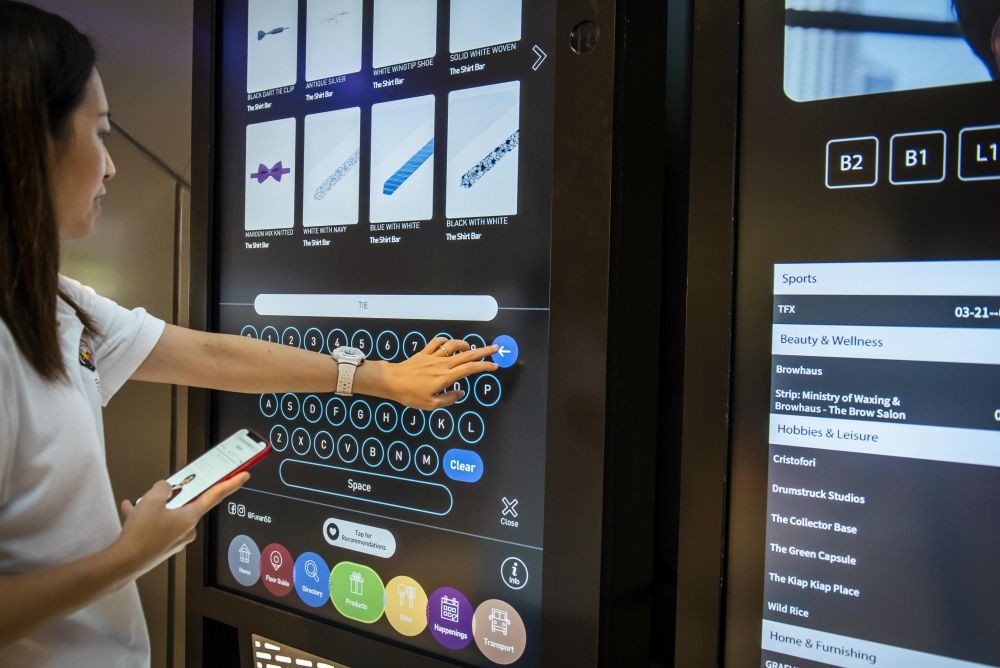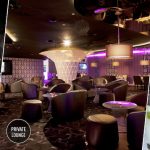The newly reopened Funan mall is unlike any other shopping mall in Singapore, which embraces omnichannel through click-and-collect services, relies heavily on technology and even operates an urban farm.
A day at Funan could look like this – As you drive to your office, which is in the WeWork co-working space in Funan, you take out your phone and book your car park slot ahead of time. Driving into the mall, you are guided to your allocated lot by the video-based smart car parking facility.
Before entering Funan’s twin office blocks to head up to the WeWork, you go through a facial recognition turnstile.

For lunch, you decide to head to the KOPItech food court, operated by Kopitiam, where you can order your food through Facebook Messenger or self-service kiosks at each stall, which accepts various forms of cashless payments including cryptocurrencies.
On the way there, you stop by the cashier-less FairPrice Finest supermarket to buy groceries and pay for them at self-service terminals through your phone.

Before heading back to work, you head up to the 5,000 sq ft urban farm, operated by Edible Garden City, located on the roof of Funan to get some fresh air.
Once there, you learn how vegetables are produced and harvested, as well as experience a variety of edible plants through smell, touch and sight.

While waiting for the lift to head to your car after work, the digital ad board near the lift is advertising different products from different retailers, all on one page.
You decide to do a little shopping and browse through the products, finding a dress you like, which you add to your wishlist by scanning a QR code. It then directs you to the Funan website, where it shares details of the collection from the Love, Bonito store.

Once at the Love, Bonito store, you pick up the dress you have chosen, book the on-demand stylist and take a number for the electronic queuing system to try it in the fitting room. As you wait for your number to flash up, you try an augmented reality walkway photo to share your shopping experience on social media with your friends.

The future of shopping malls is happening now.
CapitaLand, one of Asia’s largest real estate companies and Funan’s landlord, believes that as the retail landscape undergoes disruptions, the formula for a successful mall must evolve as well.
Chris Chong, the managing director for retail in Singapore at CapitaLand, said “Against this backdrop, CapitaLand has created Funan differently right from the onset. We envisioned Funan as a new-gen integrated development comprising retail, office and co-living components to appeal to digitally-savvy consumers pursuing a quality of life in a creative and sustainable environment,” he explains.
According to Chong, when CapitaLand was rebuilding Funan, it wanted a concept that marked a departure from the usual way of thinking of a mall as a box, with a standard checklist of retailers to tick off.
This meant building a passion-led retail model around interactive communities clustered into six passion themes of Tech, Craft, Play, Fit, Chic and Taste.
To do this, CapitaLand incorporated spaces for performance, connection, collaboration and experimentation in Funan for shoppers to explore and provided retailers with a more dynamic environment to innovate within.
The result of that was green spaces, rest areas and interactive corners to encourage visitors to discover and experience.
“At the onset when we engaged retailers about CapitaLand’s vision for Funan, many were inspired to leverage Funan as their own innovation platform.
“For example, Courts opened its first IoT-themed store, which retails the latest smart home, AI and voice-control technology from leading brands, incorporates interactive in-store experiential concepts and robotics.
Swiss sewing machine brand Bernina’s flagship store at Funan offers a new lifestyle concept that includes themed sewing workshops, machine rental service as well as gift personalisation service.”
Will malls like Funan revive the retail sector?
The rise of e-commerce has affected brick-and-mortar retailers around the world, including in Singapore, where half-empty shopping malls have become the norm, leading the sales from the 26-year-old Great Singapore Sale (GSS) to dip for three consecutive years.
It has also affected Orchard Road, which is Singapore’s main shopping belt. This has concerned the government so much that it has commissioned an S$1.3 million study by Australian urban planning consultancy firm Cistri.
As the world is moving to a ‘phygital’ environment, where physical and digital are coming together, Scott Rigby, the head of digital transformation for Asia Pacific at Adobe believes that reimagined malls like Funan can help revive the retail sector and improve retailers’ bottom line.
Charanjit Singh, the managing partner at Construct Digital, agrees, and adds that by making shopping malls more fun and attractive, people are more likely to go to the mall more often, increasing the chances of them making a purchase at the retail stores.
Social media analysis by Meltwater seems to back up Charanjit’s observations, as Funan’s offline features were what most people discussed, proving that people are responding well to experiential features.
According to Mimrah Mahmood, the regional director of media solutions at Meltwater, the analysis also shows how conversations peaked in the days following the Funan launch, not just on social media but also on forums and blogs.
Most of these conversations are neutral or positive in tone, with ‘surprise’ being the key emotion evoked in the online conversations.
However, Rigby warns a reimagined mall concept without the right focus on customer experience may draw large crowds at the initial launch with fancy technology, but be hard to sustain once the novelty wears off. That means malls and retailers must put customer experience at the core of their design and technology investments.
“For certain industries like fashion, for example, customers want to be able to feel, interact and try on fashion goods, while at the same time, wanting the convenience of making purchases at the comfort of their own home,” he explains.
“It is important for retailers to understand customer expectations and be able to merge these offline and online experiences together – after all, customers who research online before coming in stores tend to spend more after interacting physically with the brands.”
One such technology is location-based tech, suggests Redickaa Subrammanian, the founder and chief executive officer of Resulticks, is analysis on visitor traffic data to shopper behaviour to help optimise operations and advise brands within the mall.
Funan is already doing this, as CapitaLand is utilising video analytics to measure and analyse footfall throughout the mall and entering each store. It also using in-store smart terminals to further capture transaction data so that tenants can use the analytics to refine their offerings and enhance customer experiences.
Some retailers like Lenovo, have taken it upon themselves employ their own location-based tech. It has embedded its smart retail tech in its store that tracks footfall analytics and optimization, along with in-store cameras and product webcams that capture facial expressions.
This allows the brand to pinpoint the areas within the store and products that customers spend the most time on. With such information, it is able to gain insights into their preferences and cater its services to make sure we’re attuned to these details.
“The reimagined Funan is a social retail space for discovery, learning and shopping, underpinned by a digital layer of customer experience to enhance satisfaction.
“With this configuration, CapitaLand aims to support retailers in embracing opportunities in the brave new world of bricks-and-clicks by attracting and growing a responsive and vibrant community, powered by an ecosystem of sensors and analytics to deepen consumer insight,” explains CapitaLand’s Chong.
For Ritika Verma, the planning director for Singapore at Geometry Global, who recently visited Funan, the evident focus on customer experience by retailers is on display when looking around the mall.
“They are enhancing the shopper experience by attracting consumers to these beautifully designed retail stores, then engaging them with information on the product through immersive experiences (like a cycling track in-store when buying cycles), or digital screens to provide more information on the product, to driving conversion through kiosks payments, scan and go, and click and collect,” she explains.
For now, it appears that the heart of shopping malls remains for shopping. According to Jake Gammon, head of Omnibus APAC at YouGov Omnibus, when Singaporeans were polled on the main reason for visiting shopping malls, 44% said it was for shopping.
Two in ten (23%) said their main reason was for dining, and the other two in ten (20%) said they visited shopping malls to walk around.
However, Gammon says this trend is set to shift in the future. For example, while over half (52%) of respondents aged 55 and above selected shopping as their main reason for visiting a shopping mall, this drops to three in ten (31%) among those aged 18-to-24. There is also an increasing reliance on online shopping.
“Two in ten (21%) shop online, half (53%) shop in-store and the remaining one quarter (26%) shop equally online and in-store. With young people (18 to 24) twice as likely to shop online than older people (aged 55 and above (25% vs. 12%), it won’t be hard to envision shopping malls as no longer being the primary place for retail needs,” he tells The Drum.
CapitaLand currently operates 18 malls in Singapore including Funan, as well as malls in eight Chinese cities.
source: http://www.thedrum.com
MARKETING Magazine is not responsible for the content of external sites.










